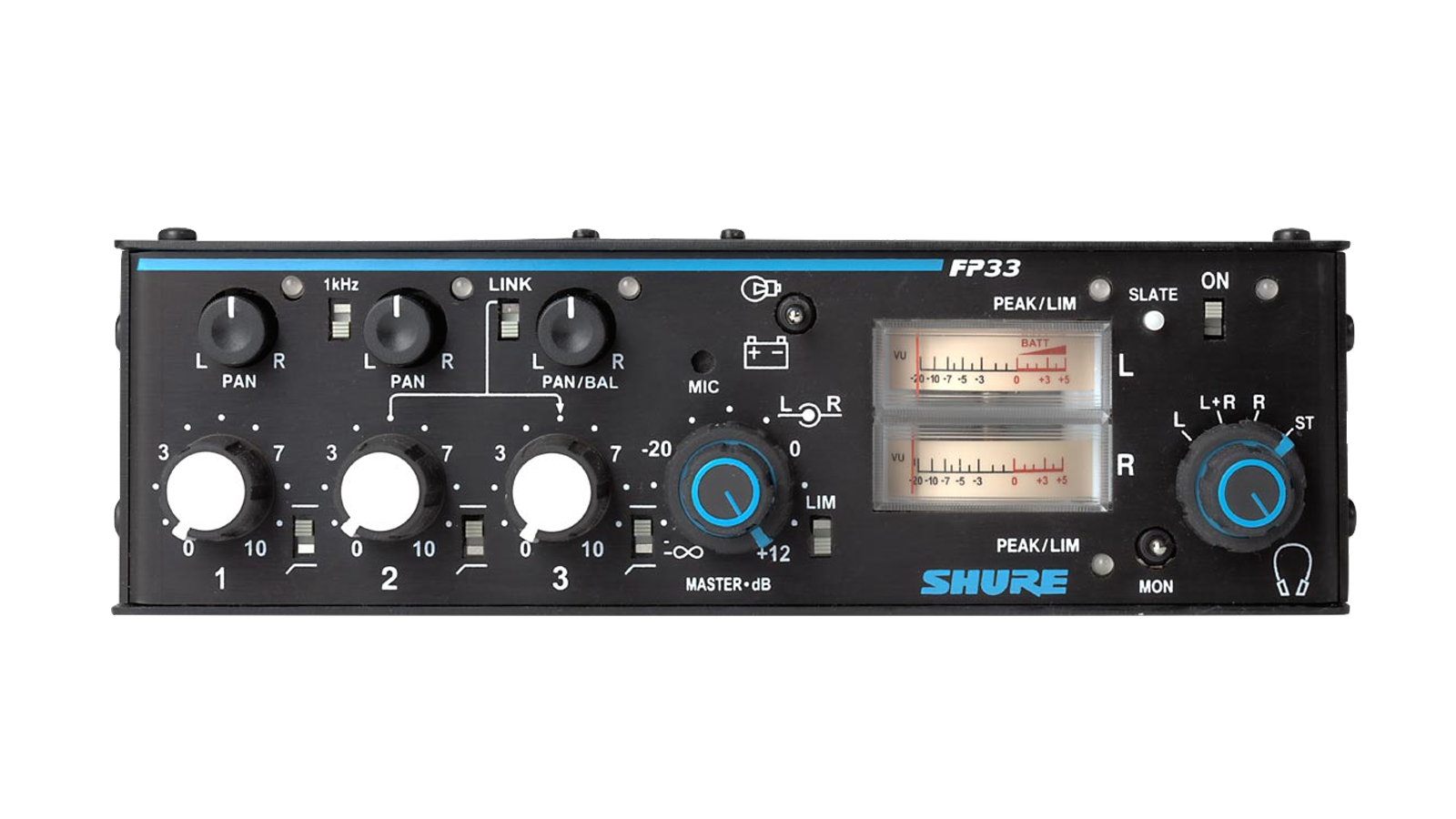MIXERS
Shure FP33 Channel Mixer
The Shure FP33 3-Channel Stereo Mixer is a field mixer suitable for electronic news gathering (ENG), field production (EFP), film, television and recording for sound design.
$60.00 P/DAY + 10% INS & GST – Auckland | Wellington
More Information
The FP33 features balanced XLR inputs and outputs, switchable between mic and line level signal. In addition the FP33 features 3.5mm Monitor input and Tape output jacks.
Quiet Audio Signal
Transformer balanced inputs and outputs result in superior rejection of RFI and electromagnetic hum.
48 and 12 Volt Phantom Power
Both 48 and 12 Volt Phantom power is supported allowing up to 8 hours of use on two 9 Volt batteries.
Mix Bus Output
The Mix Bus output jack allows users to cascade multiple FP33 mixers for simultaneous use. Also allows tandem use with the Shure FP32A.
Professional VU Meters
Professional analog VU meters are more durable against elements than LED, LCD, or fluorescent meters. The meters feature timed or toggled backlighting and are multifunctional.
Built-In Tone Oscillator
The FP33 provides a 1kHz test tone oscillator for calibration of tape machines, meters etc.
Isolated Two-Way Talk Back
Isolated two-way talk-back using Monitor In and modified Slate Mic/Tape Out jack.
4 Headphone Monitor Modes
Headphone Monitor switch allows monitoring of Left, Left + Right (Mono), Right and Stereo audio signals. Perfect for isolating either “mid” or “side” signal when using stereo microphones.
Compact Rugged Design
The Compact rugged plated metal chassis is made to withstand extreme heat and cold for full operation under harsh conditions.
Sound Devices 302 Mixer
Mixer comes with a full portabrace cover and quick release cables.
$60.00 P/DAY + 10% INS & GST – Auckland | Wellington
More Information
The 302 is the essential portable mixer for production companies and camera operators wanting to take control of their audio. The 302 can interface with any professional microphone, wireless system, or camera/recorder input.
Inputs
The 302’s inputs consist of three, full-featured microphone preamplifiers. Each input has a wide gain range to accommodate nearly all signal types. The 302 easily accepts signals from low-sensitivity ribbon and dynamic microphones, medium-level wireless and condenser mic outputs, and “hot” line-level signals.
The 302 is a two-bus mixer. Each input can be “hard panned” between the left and right output bus making it easy to use the 302 in either stereo or dual-mono operations. Because dialog is often recorded in mono, each output connector can be used to feed a separate camera or recorder. The 302’s Master XLR Outputs and Tape Outputs share the same program content.
Headphone Monitoring
The 302 has a flexible headphone circuit capable of selecting a variety of audio signals for headphone monitoring. Most professional headphones ranging in impedance from 8 ohms to 1000 ohms can be used with the 302.
Meter
The 302’s meter provides a great deal of audio signal information to the operator. The ability to view multiple ballistics, peak levels (PPM), average levels (VU), or a combination of both, is unique to Sound Devices LED-based meters. The 302 meters do not share the inherent limitations of LCD and mechanical meters. LCD-based meters can have sluggish indications in cold temperature. Mechanical meters can be fragile and not ideal for field use.
Mixer Linking
To add inputs to the 302, an additional mixer can be connected (linked) into its Mix In connection. The unbalanced Mix In connection is directly compatible with Sound Devices MixPre, 302, and 442 mixers. A simple connection between those mixer’s Mix Out/Tape Out and the 302 Mix In, adds their input channel to the 302’s output bus. The unit connected via the Mix In will contain all inputs.
Power
The 302 can be powered from either internal batteries or from external DC. The power-efficient 302 can operate from three AA alkaline batteries for nearly a production day (less with phantom powering). While many users prefer external DC sources to power both their mixer and wireless receivers, the use of internal batteries is perfectly feasible for both primary and backup powering of the 302.



